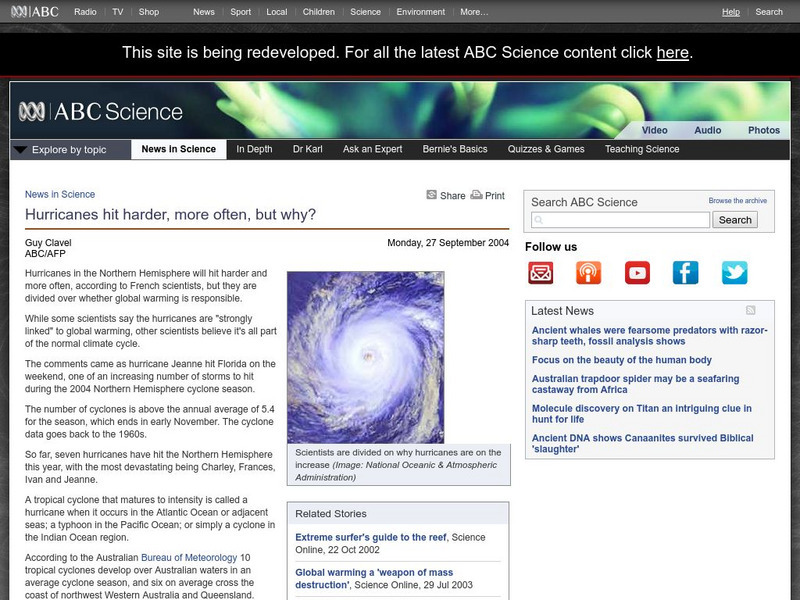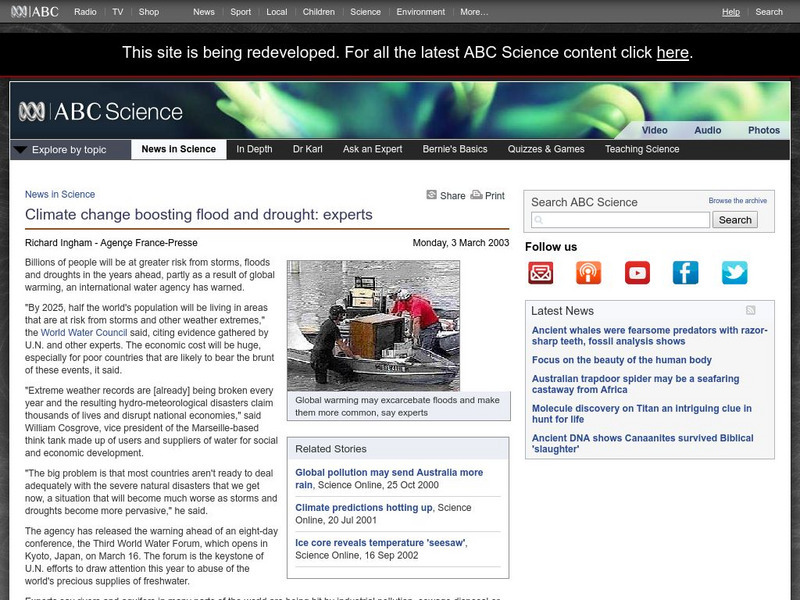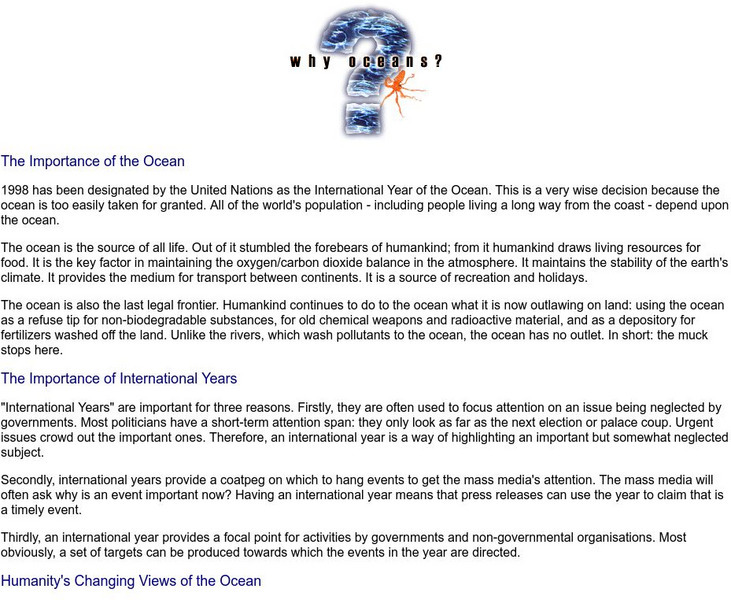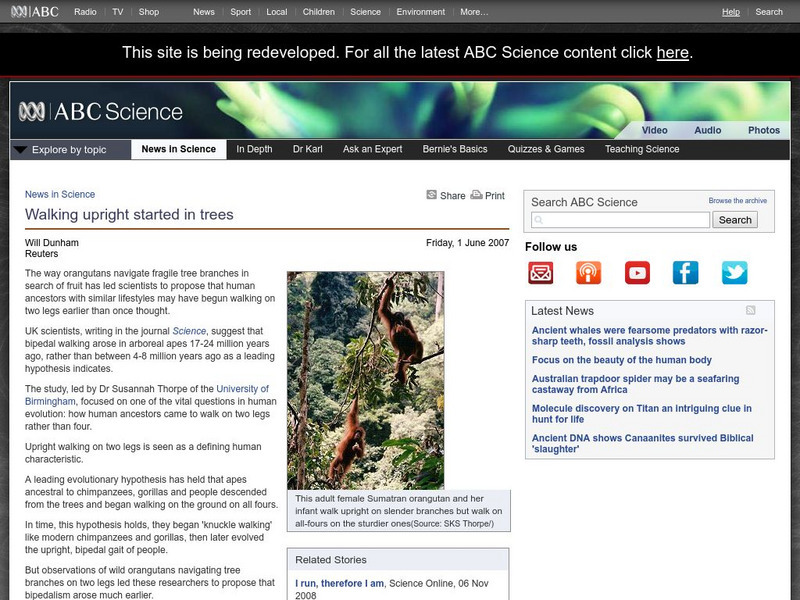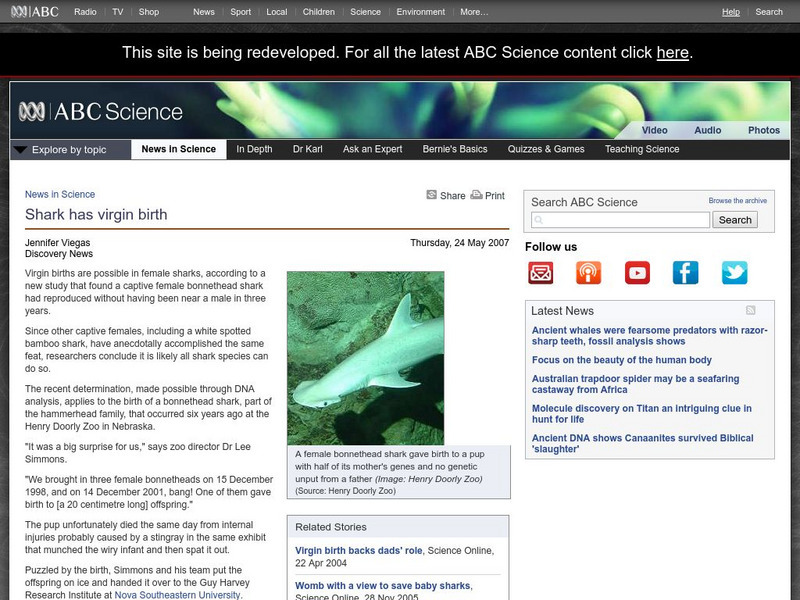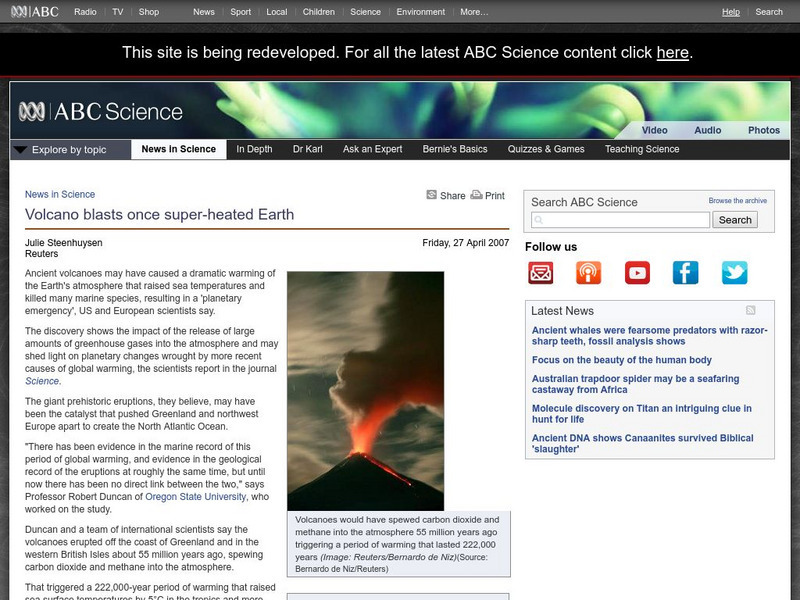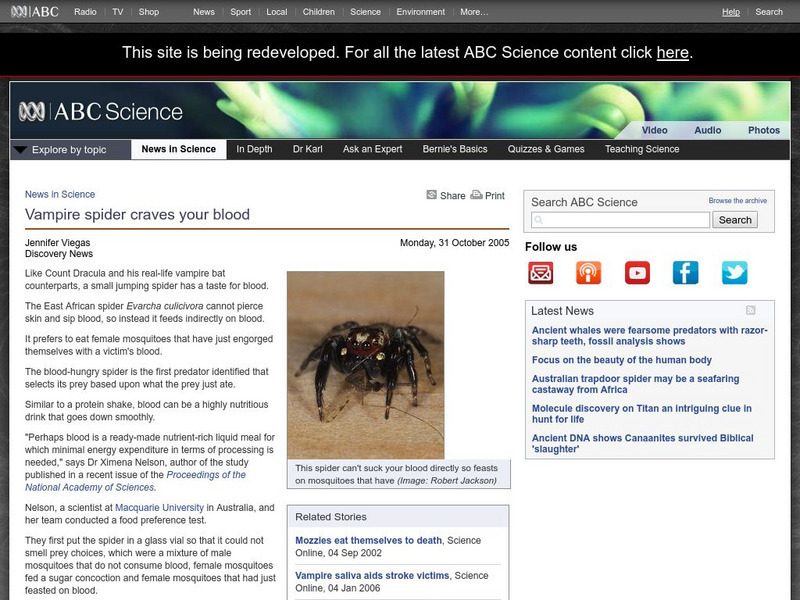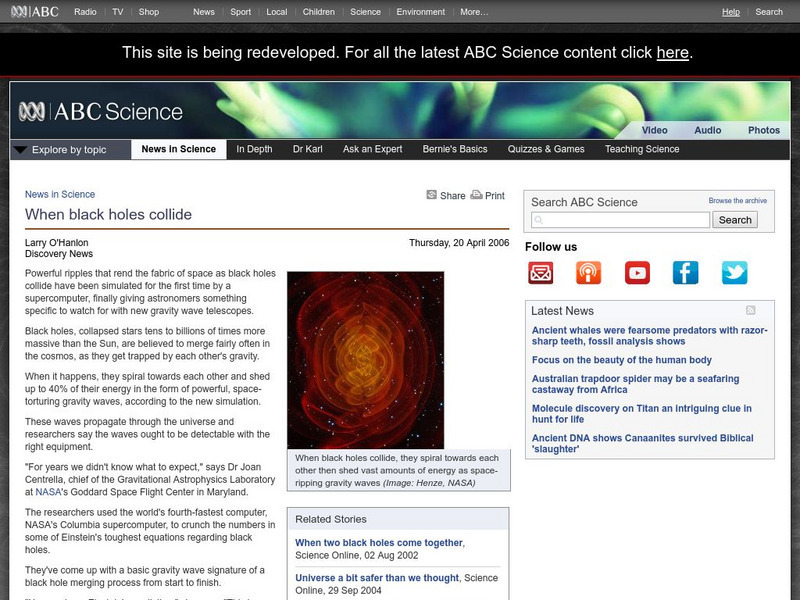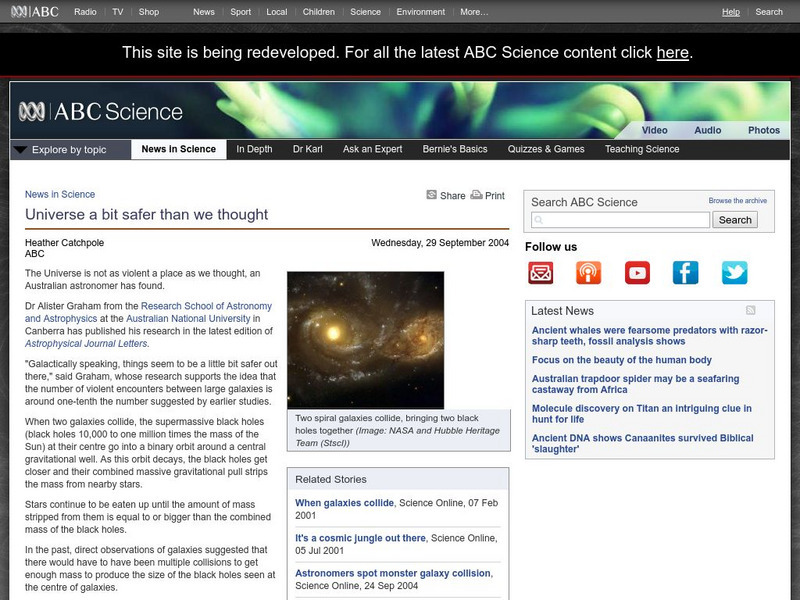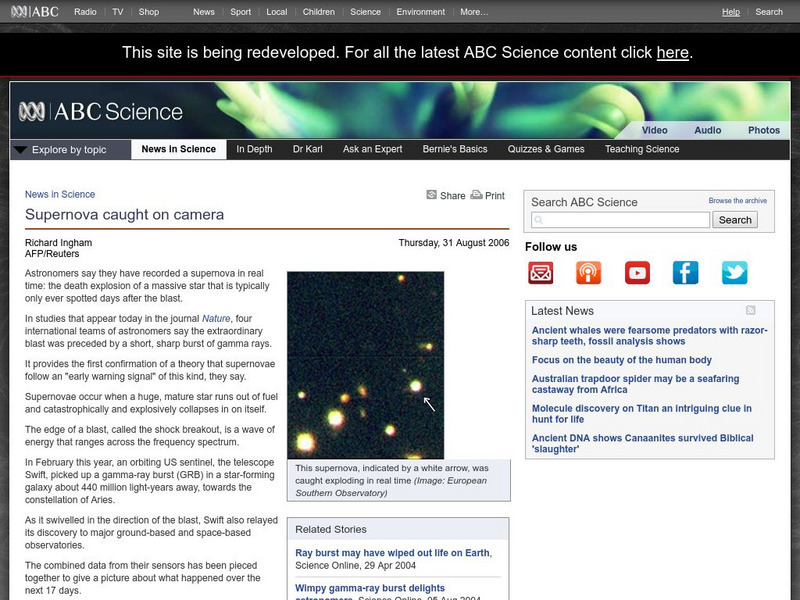Australian Broadcasting Corporation
Australian Broadcasting Corporation: News in Science: Hurricanes Hit Harder, More Often, but Why?
From ABC News in Science, Guy Clavel's article deals with research by French scientists which suggests that hurricanes in the Northern Hemisphere will continue to intensify in severity.
Australian Broadcasting Corporation
Australian Broadcasting Corporation: News in Science: Climate Change Boosting Flood and Drought
From ABC News in Science, this article deals primarily with the affect on severe weather brought about by climate change. The article also deals with the risk brought about by this severe weather.
Australian Broadcasting Corporation
Australian Broadcasting Corporation: News in Science: Dogs Really Do Look Like Their Owners
From ABC News in Science, Anna Salleh's article discusses the findings of a U.S. study related to dogs looking like their owners. The study also deals with the purebred vs. mongrel issue in choosing a dog.
Australian Broadcasting Corporation
Australian Broadcasting Corporation: News in Science: Dogs Do Have Personalities
From ABC News in Science, Jennifer Viegas's article deals specifically with the issue personality and its manifestation in dogs. The article utilizes findings from the research of Professor Samuel Gosling.
Australian Broadcasting Corporation
Australian Broadcasting Corporation: Why Oceans?
This site, which is provided for by the Australian Broadcasting Corporation, gives an article on the importance of the ocean. Everyone on earth depends upon the oceans. Learn why oceans are important and what Australia is doing to help...
Australian Broadcasting Corporation
Australian Broadcasting Corporation: News in Science: Vesuvius (World's Most Dangerous Volcano)
An article outlines the reasons why Vesuvius should be considered the world's most dangerous volcano.
Australian Broadcasting Corporation
Australian Broadcasting Corporation: News in Science: Secrets of the Sun's Sizzling Corona
From ABC News in Science, Larry O'Hanlon's article on the sun's corona covers information related to the inner workings of the sun. Several included topics are "Sound makes heat" and "Reaching the surface."
Australian Broadcasting Corporation
Australian Broadcasting Corporation: News in Science: Walking Upright Started in Trees
From ABC News in Science, Will Dunham's article on orangutans covers topics related to the evolutionary process of "bipedal walking," or walking on two legs instead of four.
Australian Broadcasting Corporation
Australian Broadcasting Corporation: News in Science: Why Animals Have Attitude
From ABC News in Science, Marlowe Hood's article on animals with attitude covers topics related to the evolutionary process whereby certain animals within the same species can react differently in given situations based on differing...
Australian Broadcasting Corporation
Australian Broadcasting Corporation: News in Science: Swimming Dinosaurs
From ABC News in Science, Will Dunham's article, "Swimming dinosaurs touched bottom of lake," explores fossilized foot marks found on a lake bottom which suggest strong swimming ability on the part of the dinosaurs.
Australian Broadcasting Corporation
Australian Broadcasting Corporation: News in Science: Shark Has Virgin Birth
From ABC News in Science, Jennifer Viegas's article covers results from a recent study in which a female bonnethead shark was able to reproduce without the presence of a male shark.
Australian Broadcasting Corporation
Australian Broadcasting Corporation: News in Science: Southern Ocean Carbon Sink Filling Up Fast
From ABC News in Science, Deborah Zabarenko's article explores the rising danger of the amount of carbon dioxide currently filling up the southern ocean around Antaratica.
Australian Broadcasting Corporation
Australian Broadcasting Corporation: News in Science: Universe May Disappear From View
From ABC News in Science, Larry O'Hanlon's article on the universe presents research related to the expanding of the universe and the corresponding distance between planetary objects.
Australian Broadcasting Corporation
Australian Broadcasting Corporation: News in Science: Snapped! Jupiter's Second Red Spot
From ABC News in Science, this article focuses on the discovery of a second red spot on the planet Jupiter. The spot, Red Spot Junior, is discussed in the brief article and is accompanied by a picture.
Australian Broadcasting Corporation
Australian Broadcasting Corporation: News in Science: Volcano Blasts Once Super Heated Earth
From ABC News in Science, Julie Steenhuysen's article explores the results of ancient volcanic eruptions that caused a warming effect on the Earth and possibly caused the death of certain species.
Australian Broadcasting Corporation
Australian Broadcasting Corporation: News in Science: T Rex Thigh Shows Chicken Family Ties
From ABC News in Science, Julie Steenhuysen's article explores the evolutionary link between the ancient Tyrannosaurus rex (T-Rex) and the modern chicken.
Australian Broadcasting Corporation
Australian Broadcasting Corporation: News in Science: Sun's Magnetic Field
From ABC News in Science, this article, "Sun's magnetic field twisted and tangled," discusses images taken of "plumes of gas" which are rising from the sun's corona.
Australian Broadcasting Corporation
Australian Broadcasting Corporation: News in Science: Vampire Spider Craves Your Blood
From ABC News in Science, Jennifer Viegas's article discusses issues related to the East African spider Evarcha culicivora (a small jumping spider) which evidently chooses its prey based on what that prey just ate.
Australian Broadcasting Corporation
Australian Broadcasting Corporation: News in Science: Solar Flare Largest Ever Seen
From ABC News in Science, Larry O'Hanlon's article charts the discovery of the largest solar flare ever seen, occurring withint the constellation Pegasus. The article also discusses the consequences of such a large solar flare.
Australian Broadcasting Corporation
Australian Broadcasting Corporation: News in Science: Violent Storm Rages on Saturn
From ABC News in Science, Irene Klotz's article discusses the first storm in the history of the solar system (with the exclusion of storms on Earth) to develop a hurricane-like eye.
Australian Broadcasting Corporation
Australian Broadcasting Corporation: News in Science: When Black Holes Collide
From ABC News in Science, Larry O'Hanlon's article on black hole collision discusses the process of the collisions and the means by which scientists track and collect data from these collisions.
Australian Broadcasting Corporation
Australian Broadcasting Corporation: News in Science: Universe a Bit Safer Than We Thought
From ABC News in Science, Heather Catchpole's article explores issues related to the collision of galaxies and the subsequent formation of black holes.
Australian Broadcasting Corporation
Australian Broadcasting Corporation: News in Science: The Planet Formerly Known as Pluto
From ABC News in Science, this article discusses issues related to Pluto its removal from planetary status. The brief article also touches on the renaming and re-listing process of Pluto.
Australian Broadcasting Corporation
Australian Broadcasting Corporation: News in Science: Supernova Caught on Camera
From ABC News in Science, Richard Ingham's article explores information relating to footage of the explosion of a star. The article also deals with what happens in the aftermath of a supernova.


